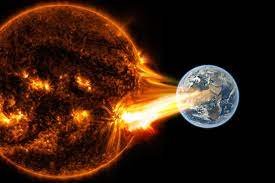A NASA model indicates that one of the solar storms or precisely coronal mass ejections (CMEs) could strike Earth in the next few days, with one potentially hitting our magnetic field and atmosphere late on November 25. Once scientists have completed their analysis of the storm tracks, this will be verified.
On August 7, 2023, NASA’s Solar Dynamics Observatory took this picture of a solar flare, at 4:46 p.m. EDT, released by the Sun which can be seen as the brilliant light on the right side. The image displays a portion of severe ultraviolet light that is colorized in yellow and orange and highlights the substance that is highly hot in flares.
On the surface of the sun, sunspots are black areas of concentrated magnetic energy. Solar flares, which are dazzling blasts of electromagnetic radiation, frequently originate from them. Four categories are used to classify solar flares: A, B, C, M, and X, where X is the strongest.
Solar flares are intense energy eruptions. Solar eruptions and flares can endanger astronauts and spacecraft as well as have an impact on electric power systems, navigation signals, and high-frequency (HF) radio communications.
Storms happening in Space!
Spaceweather.com reports that within the last week, the number of sunspots has increased by a factor of 10, giving the sun the appearance of a massive pepperoni pizza.
On November 18, the first sunspot group, AR3490, appeared on the northeastern side of the sun facing Earth, sparking the start of the sunspot tale. Not very long afterward, AR3491, another sunspot group, formed a track behind the first. Because they had noticed “helioseismic tremors,” or movements in the sun, the scientists had predicted the coming of these sunspot groups.
An X1.5 flare is the designation given to this one. The number tells you more about the strength of the flare, and X-class indicates the strongest flares.

According to Daniel Brown, an associate professor of astronomy and science communication at Nottingham Trent University in the United Kingdom, “solar flares and CME are both caused by the sun through its magnetic field being twisted and stressed through motions in the sun,” stated to Newsweek.
On the other hand, a solar flare is a massive outburst of light caused by the sun’s magnetic fields breaking and reorganizing. That usually goes hand in hand with a CME release. However, the particles will take a day or longer to arrive, whereas the light and radiation arrive at our location in less than eight minutes. A simple way to think of it is that a CME is like a traveling cannonball, but a flare is like a muzzle flash.
What’s a Geomagnetic storm?
A geomagnetic storm can be caused when a CME’s particles collide with the Earth’s atmosphere and magnetic field.
According to Huw Morgan, who heads the Solar Physics group at Aberystwyth University in the United Kingdom, “a geomagnetic storm occurs when the Earth’s magnetic field is seriously disrupted by eruptions from the sun,” Newsweek was informed. “When a large plasma storm erupts from the sun, and that storm carries a magnetic field which is oriented in an opposite direction to Earth’s magnetic field, we have a ‘perfect storm,’ and a larger geomagnetic storm.”

Based on the strength of the CME that generated them, geomagnetic storms range in intensity from G1 (small) to G5 (severe), according to NOAA. The storms with the greatest intensity are the least frequent over an 11-year solar cycle, there may be 1700 G1 storms, but only 100 G4 storms and 4 G5 storms.
What’s the impact of these storms?
More intense storms lead the northern lights to move further and further south, and these geomagnetic storms can produce beautiful aurora displays much nearer towards the equator than usual. This happens because the solar plasma that strikes us affects and disturbs charged particles in the Earth’s atmosphere, which then reacts with gasses like nitrogen and oxygen in the air to cause them to glow.
“Under quiet circumstances, charged particles from the solar wind and the ionosphere may get stuck in the magnetosphere and joyfully bounce from pole to pole and hemisphere to hemisphere. According to Brett Carter, an associate professor of space science at RMIT University in Australia, “under these conditions, some of these charged particles will collide with upper atmospheric particles, causing auroras in the polar regions,” Newsweek reported.

But when a CME strikes and triggers a geomagnetic storm, these particles are driven farther into the atmosphere, where they interact with more molecules to intensify and prolong the aurora’s visibility.
“The infrastructure that is most damaged is large-scale electricity networks, which are essential to the operation of modern society. Apart from that, there is a major impact on satellites in orbit, pipelines, and High Frequency (HF) radio and radar, according to Carter. It is also known that geo-magnetically induced currents in pipelines hasten the pace of corrosion in certain pipelines.
The plasma environment in orbit can cause higher surface charging in satellites, which can have an impact on the satellite’s onboard electronics and overall performance.

Furthermore, the atmosphere actually swells as a result of the enormous amount of energy that these large storms dump into it, which increases satellite drag in low-Earth orbit (up to roughly 1,000 km height, where the majority of our satellites are).
The task of monitoring everything in orbit and preventing collisions is made more difficult by increased satellite drag. Variable satellite drag can hamper space operations, as demonstrated by the very mild geomagnetic storm in February 2022 that caused most of a Starlink deployment to be lost.”
NASA’s take on Solar Storms
Space.com reports that NASA’s probe indicates that solar activity will probably increase till the solar maximum is anticipated in 2025.
Due to increased radiation exposure, the increased solar activity puts satellites, spacecraft, and even spacewalking astronauts at danger.
Earth will be at risk from the solar activity as well because it will cause massive geomagnetic storms that could disrupt global positioning systems and high-frequency radio communications (GPS). An internet outage, or shutdown of the internet, could result from this. But the exact time and date of this activities are still undetermined.












Comments 1